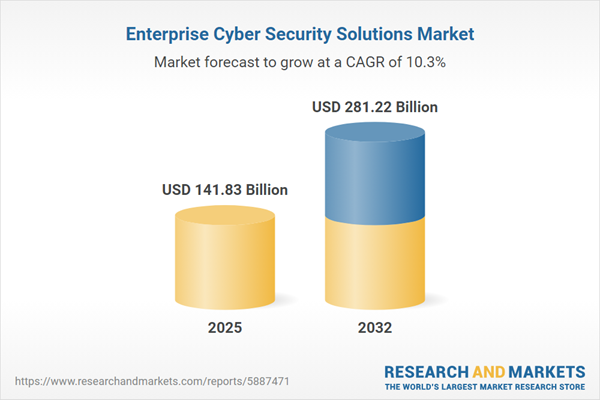Speak directly to the analyst to clarify any post sales queries you may have.
Enterprise cyber security solutions enable organizations to confidently navigate digital transformation, supporting operational efficiency and secure growth. Senior decision-makers increasingly prioritize integrated platforms to safeguard evolving business models and regulatory needs.
Market Snapshot: Enterprise Cyber Security Solutions
The enterprise cyber security solutions market is currently valued at USD 128.45 billion and forecasted to reach USD 141.83 billion by 2025, with a CAGR of 10.29 percent. Expanding digitization, rapid cloud migration, and proliferating IoT integration are driving increased demand for robust security platforms. Organizations must address stricter regulatory mandates, leading to investments in adaptive, scalable cyber security frameworks suited to heterogeneous digital environments. Technology leaders recognize the necessity of cohesive security solutions to maintain business continuity, support compliance, and enable future transformation.
Scope & Segmentation of Enterprise Cyber Security Solutions
- Solution Type: Cloud security integrates encryption, policy controls, and broad visibility across distributed IT landscapes. Endpoint protection is essential for mitigating malware threats and automated incident response. Identity and access management provides multifactor authentication and manages privileged access, reducing insider risks. Network security ensures strong perimeter defenses, advanced threat detection, and the secure movement of data internally and externally.
- Deployment Mode: Hybrid, private, and public cloud configurations support flexible integration with existing infrastructure or migration strategies. On-premises deployment remains necessary for organizations with distinct regulatory or residency requirements.
- Application: Integrated platforms streamline compliance management, enable real-time behavioral analytics, and support rapid incident response, enhancing decision-making in complex IT ecosystems.
- Customer Type: Large enterprises rely on comprehensive, resilient frameworks to protect expansive operations, while small and medium-sized businesses implement tailored solutions that reflect unique risk profiles and operational needs.
- Industry Vertical: Sectors including financial services, healthcare, government, utilities, energy, manufacturing, IT, and retail each encounter specific regulatory demands, necessitating aligned processes and specialized security measures.
- Region: Adoption levels and use cases vary across the Americas, EMEA, and Asia-Pacific due to differences in digital maturity and legal requirements. Countries such as the United States, Germany, China, India, and Australia play significant roles, each driven by local compliance standards.
- Leading Vendors Profiled: Cisco Systems, Palo Alto Networks, Fortinet, Check Point Software Technologies, IBM Corporation, CrowdStrike, Trend Micro, Sophos, Splunk, and McAfee Corp offer solutions addressing sector-specific needs and evolving compliance requirements.
Key Takeaways for Senior Decision-Makers
- Adopting enterprise cyber security solutions that span hybrid environments enables ongoing protection against increasingly complex threats.
- Aligning security with regional regulatory frameworks facilitates better governance and improves operational efficiency across global operations.
- A cloud-first or hybrid approach offers future-focused support and agility as business demands and compliance standards develop.
- Tailoring security frameworks by industry sector raises process efficiency, especially in regulated fields such as financial services and healthcare.
- Utilizing managed security services and automation enhances resilience, streamlines procurement, and supports effective oversight.
- Adjusting risk and compliance frameworks to local conditions ensures optimal investment and protection relative to geographic and organizational needs.
Impact of Recent United States Tariff Policies
Recent adjustments to United States tariff frameworks have increased costs associated with imported cyber security hardware and software. In response, many organizations are accelerating transitions to cloud-native security models and seeking domestic suppliers. This development emphasizes the value of agile procurement strategies and resilient digital infrastructure to respond to ongoing global trade and geopolitical shifts.
Enterprise Cyber Security Solutions Market Methodology & Data Sources
Research draws from interviews with security and risk leaders across multiple sectors and regions. Findings were validated through industry benchmarks, regulatory standards, and peer-reviewed research, ensuring practical relevance. Cyber security experts contributed insights to guarantee the actionability of conclusions.
Why This Report Matters
- Executive teams can strategically align investments with changing cyber risk landscapes, maximizing measurable value for the organization.
- Procurement and security decision-makers are equipped with a robust framework for comparing technologies by deployment, application, or geography, improving solution selection.
- Sectors with and without regulatory obligations can strengthen security postures and maintain business continuity using the report’s actionable insights.
Conclusion
Applying these insights helps leaders synchronize security and transformation objectives. Maintaining a focus on resilience and compliance prepares organizations for the evolving digital threat environment.
Additional Product Information:
- Purchase of this report includes 1 year online access with quarterly updates.
- This report can be updated on request. Please contact our Customer Experience team using the Ask a Question widget on our website.
Table of Contents
3. Executive Summary
4. Market Overview
7. Cumulative Impact of Artificial Intelligence 2025
Companies Mentioned
The companies profiled in this Enterprise Cyber Security Solutions market report include:- Cisco Systems, Inc.
- Palo Alto Networks, Inc.
- Fortinet, Inc.
- Check Point Software Technologies Ltd.
- IBM Corporation
- CrowdStrike Holdings, Inc.
- Trend Micro Incorporated
- Sophos Ltd.
- Splunk Inc.
- McAfee Corp.
Table Information
| Report Attribute | Details |
|---|---|
| No. of Pages | 190 |
| Published | November 2025 |
| Forecast Period | 2025 - 2032 |
| Estimated Market Value ( USD | $ 141.83 Billion |
| Forecasted Market Value ( USD | $ 281.22 Billion |
| Compound Annual Growth Rate | 10.2% |
| Regions Covered | Global |
| No. of Companies Mentioned | 11 |









